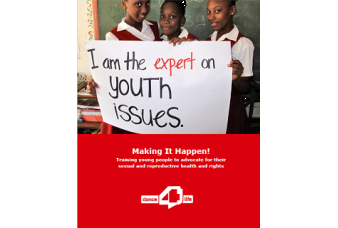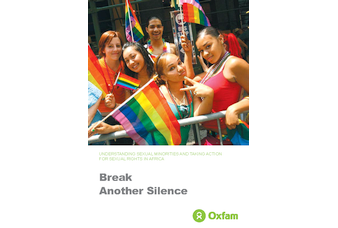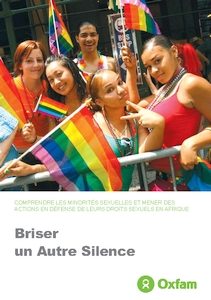Making It Happen! Training young people to advocate for their sexual and reproductive health and rights
I developed this advocacy training manual for dance4life, based on activities which they had developed. The manual is accompanied by handouts and a facilitators’ journal, and is also available in Spanish.
Download (6.7Mb)
Extract
Some changes just happen; the ground becomes wet because it is raining. But most changes come from someone; the idea to build a shelter to keep dry in the rain, then the work to build it. This training is about enabling young people to create change, to use their ideas and their voices effectively to influence others and to make things happen.
dance4life believes that advocacy is crucial if we are to achieve long term changes which benefit large numbers of young people and the wider community. The drive for those changes should come from young people themselves. They know best the issues they face and the changes that are needed. With support from relevant organisations young people are the best representatives of young people’s issues.
What is the purpose of this training manual?
It’s written to enable (advocacy) staff and facilitators of dance4life National Concept Owners (NCOs) to train young people in national lobby and advocacy. It’s a tool you can use to:
- Strengthen the knowledge and capacity of young people through learning about advocacy.
- Help young activists to figure out what they most want to change with regard to their sexual and reproductive health and rights (SRHR).
- Give them meaningful involvement in refining, finalising and implementing your advocacy plans.
Creating a positive learning context
Remember how boring it can be, being taught? How the teacher’s voice goes on, and your mind wanders? Feeling frustrated there’s no chance to speak? Or feeling worried that you’ll get something ‘wrong’? This training should be NOTHING like that! It will be fun and creative and involve everyone, without fear and anxiety.
Your role is not to be the teacher or the expert! Instead you are a facilitator: someone who eases a process of learning and discovery. The methods in the training sessions help this to happen; they enable participants to figure out things for themselves, rather than being told. Your task is to create a positive context for their learning in the following ways:
- Lead by example, with a positive approach, willingness to listen, and respectful behavior.
- Give the sessions structure by following the training plan, explaining what to do, and keeping time.
- Support groups to stick to the task they are doing, rather than go off the topic.
- Be open to unexpected but important discussions and be flexible in adapting the plan, explaining changes as needed.
- Manage how people interact, if necessary, so everyone has the opportunity to add their voice, and no one dominates.
- Respond to any problems that arise, perhaps by asking the group what to do.
- Provide everyone with a chance to give feedback about the training and to improve the process.
- Praise participants for their efforts, and the virtues and leadership they have shown.
- Use humour and a diplomatic approach to deal with conflicts within the group.
DOWNLOAD full PDF. (6.7Mb)










